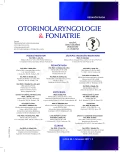Occupational Noise-Induced Hearing Impairment. Part 2
Authors:
I. Havelková
Authors‘ workplace:
ORL oddělení, Oblastní nemocnice Kolín, a. s., Kolín
Published in:
Otorinolaryngol Foniatr, 66, 2017, No. 2, pp. 75-80.
Category:
Review Article
Overview
Occupational hearing impairment caused by long-term noise exposure results in irreversible change – basocochlear sensorineural hearing loss which can be assessed by the means of the tone audiometry. Subsequently, audiology test results enable to analyze the hearing loss percentage (Fowler method) and to assess the noise-induced hearing impairment for the purposes of preventive healthcare. Prevention is the sole method capable of reducing the occurrence of the occupational noise-induced impairment. The prevention healthcare criteria are clearly defined and easily adhered to (11). A retrospective study on the occurrence of the occupational noise-induced hearing impairment in the Czech Republic (1973-2014) was carried out on the set of data contained in the National Institute of Public Health annual reports – the registry of the occupational diseases (14). Furthermore, a pilot analysis was performed on the sample of 283 noise-exposed patients who underwent the preventive healthcare check at the otorhinolaryngology ambulance of the Zelený Pruh Health Centre (Jan 2013 – May 2015). This medical survey allowed to evaluate the preventive healthcare and to compare the outcomes on the national as well as the lowest (ambulance) level. The occurrence of the occupational noise-induced hearing impairment has decreased significantly (up to 20 cases per year). Out of 283 patients, 131 suffered from the sensorineural hearing loss, three of them reaching the level of industrial disability. The declining number of the reported cases may lead to the false assumption that the issue of occupational noise-induced hearing impairment is neither serious nor topical.
KEYWORDS:
occupational noise-induced hearing impairment, industrial disability, occupational noise-induced hearing loss, occurrence, preventive healthcare
Sources
1. Čihák, R.: Anatomie 3. Grada publishing, 1997, s. 605 623.
2. Hybášek, I., Vokurka, J.: Otorinolaryngologie. Karolinum, 2006, s. 313-317, 319-324.
3. Kabátová Z., Profant M. a kolektiv: Audiológia. Grada Publishing, 2015.
4. Klozar et al.: Speciální otorinolaryngologie, Galén, Univerzita Karlova v Praze, Karolinum, 2005, s. 202-203.
5. Králíček, P.: Úvod do speciální neurofyziologie, Karolinum.
6. Lejska, M., Havlín, R.: Kam směřuje léčba sluchových vad? Congress Audiology Now Denver, April 2007, World Conference Pediatric Audiology; Ottawa May 2006.
7. Lejska, M.: Vývoj sluchové poruchy u pracovníků v riziku hluku. Pracovní lékařství, 2001.
8. Provazník, K., Komárek, L., Cikrt, M.: Manuál prevence v lékařské praxi, prevence nepříznivého působení faktorů pracovního prostředí a pracovních procesů, Státní zdravotní ústav, 1998, s. 506.
9. Sedláček, K.: Koncepce pojmu vnímavosti a odolnosti vůči poškození sluchu hlukem. Česká otolaryngologie, 1972.
10. Sedláček, K.: Symetrie sluchových ztrát u cídičů oceli. Česká otolaryngologie, 1952.
11. Tuček, M., Cikrt, M., Pelcová, D.: Pracovní lékařství pro praxi, příručka s doporučenými standardy. Grada Publishing, Avicenum, 2005, s. 125-133.
12. Vrabec, P., Lischkeová, B., Světlík, M., Skřivan, J.: Rovnovážný systém, I obecná část, Triton, 2002, s. 25-27.
13. www.khsstc.cz
14. www.szu.cz (Publikace - Data a statistické údaje - Nemoci z povolání ČR).
15. Sluchové systémy makei - propagační materiály
16. eOtorinolaryngologie.
Labels
Audiology Paediatric ENT ENT (Otorhinolaryngology)Article was published in
Otorhinolaryngology and Phoniatrics

2017 Issue 2
Most read in this issue
- Deep Neck Space Infections – Diagnostic and Therapy
- Occupational Noise-Induced Hearing Impairment – Part 1
-
Incidence of Complications in Operations on Thyroid Gland.
A Retrospective Analysis - CONE BEAM CT: použití mimo stomatologii
